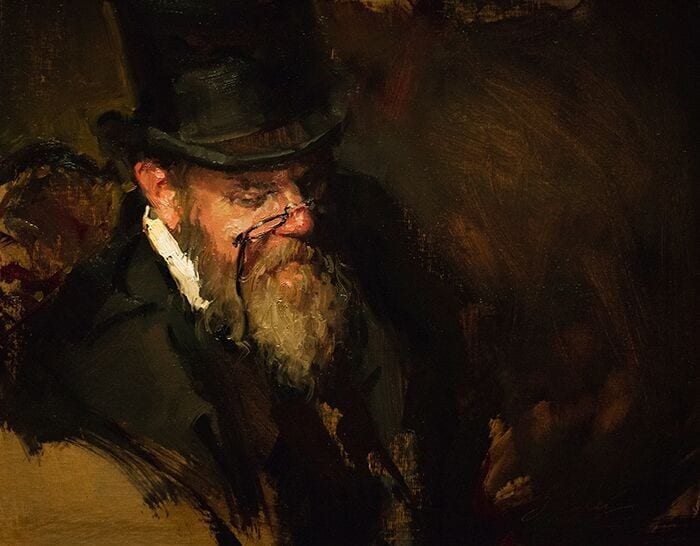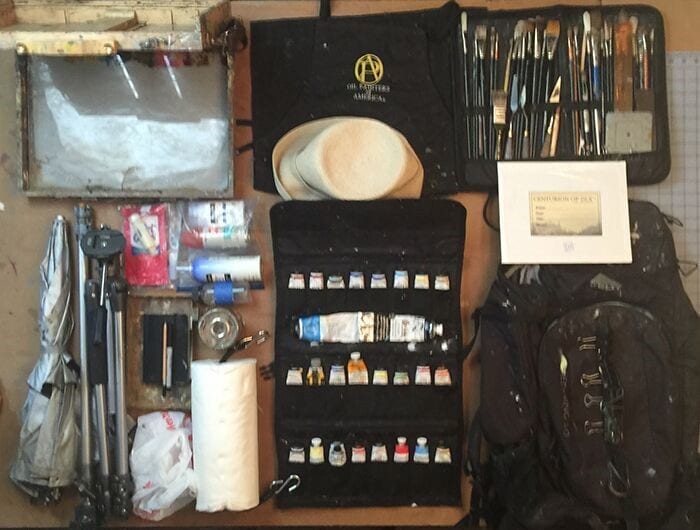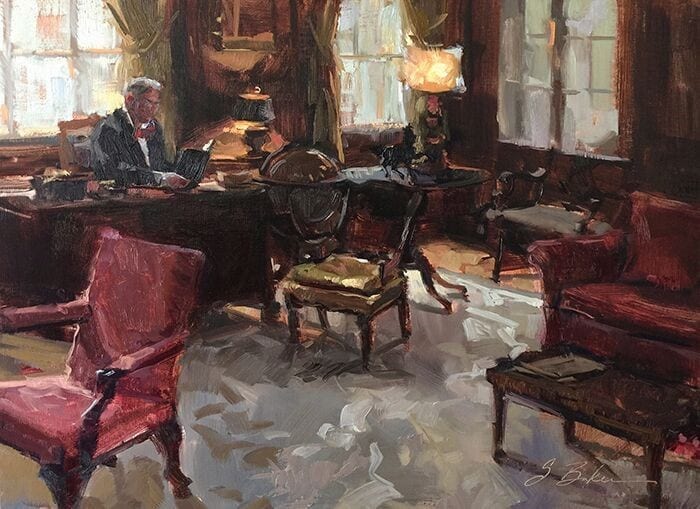I had the privilege of meeting Suzie Baker, briefly, at the Oil Painters of America (OPA) National Convention, held in Dallas, a few years ago. However, the first time I became acquainted with her work was when she won the Artist’s Choice Award during the 2014 Outdoor Painters Society “Plein Air Southwest Salon”, of which we are members.
The painting, “A Negative View of Saloons”, was surely a runaway favorite, as it is phenomenal.


She is a woman of high energy and enthusiasm; you can see it in her work. She’s also the newly elected OPA Vice President.
I wanted to interview Suzie a few years ago, but she refused…giving some lame excuse like, “Not qualified, not ready”. Well, in my book she was ready then, but now, even more so. She’s won a ton of awards…wins something in just about every competition she enters. She has plenty to offer. You’ll enjoy this.
How has your advertising background helped you as a fine artist? Working as a designer and then an art director, the “real world” gave me exposure to a professional environment as an employee; then, the stakes were not as high as going it alone as an independent artist. The value of working in a professional environment, using design and photo editing software on a daily basis, prepping jobs for print, meeting with clients, and directing illustrators and photographers were all valuable tools I could bring to bear as I segued into being a full-time artist. My design work and painting overlapped some too so that I could supplement those early lean years with design income.
Your landscapes reflect an absolute joy of painting, is that because they are rapidly painted or is it something else? I’m glad you see joy in my work. It is an intention of mine that my work have a spontaneous, confidence to it, but like Dolly Parton says, “It cost a lot of money to look this cheap!” Similarly, it takes a lot of planning to look this spontaneous.
Do you believe one’s style of painting reflects their personality; if so, what’s your style say about you? I suspect one’s work must be an amalgamation of personality, life experience, training, social/historical trends and market forces. I first landed on my preference for direct painting in college. While we learned to paint in the layered approach of the old masters, we also learned to paint in the direct manner of Manet and the Impressionists. I can point to one assignment that had a profound effect on my painting style. My professor, Peter Jones, arranged two still life’s of simple flower cuttings in glass jars. Once our palettes were loaded and brushes were ready, we had 30 minutes to finish each painting, one right after the other. I didn’t have time to overthink, I just painted. The result of which was a revelation of free and expressive mark making that I strive for even to this day. I feel like I need to qualify this experience with a note that I had already had extensive drawing experience and instruction, many painting classes, as well as color theory and design, and so forth. If my professor had given this assignment on the first day of Painting 101, I suspect my memory of it would have been one of discouragement rather than exhilaration.


Continuing with that thought, do you think one’s personality can be a limiting factor in the type of work they’ll create? I can only speak for myself here, but I would have to take medication to paint in a hyper-realistic way, or as the old masters did, with layer upon layer of glazes. I feel overwhelmed just imagining myself painting that way. However, I sure do admire when others do it well. I think the primary limiting factor in the work we create is not our personality, but rather the junk we throw in our path that stops us from creating in the first place. Steven Pressfield calls all that junk, “resistance”, in his book The War of Art. This book should be dog-eared and highlighted; if an audio book, it should be a part of every artist’s bookshelf or digital library…and listened to regularly. It’s a good ol navel-gazing romp that leads to the kick-in-the-pants we need on a regular basis. Also, check out, Art and Fear, by David Bayles and Ted Orland.
There are many differing opinions as to what qualifies as a plein air painting: in your mind, what qualifies? I think the definition matters most in plein air competitions where painting in the open air from life is the stated, or at the very least, implied expectation. They stamp blank canvases for a reason after-all! “En Plein Air Texas” specifically stipulates in their rules that no photography may be used in the production of competition paintings. An artist might however touch-up or minimally fix a troubling passage in a painting, away from the scene. I have no problem with that, but I do take issue with an artist who substantially paints their canvases in the comfort of their host home. If I’m out freezing, or sweating, or up at the crack of dawn, they should be too!!!!
When you paint en plein air, what do you hope to accomplish? I’ve got two answers for this question, depending on the circumstances. While painting at a plein air event/competition, first and foremost, I want to paint a worthy painting, a painting that I would be glad for a collector to purchase and hang on their wall, a painting that requires no qualifier of, “It was painted in 2-3 hours.” The long-term merit of a painting will not be judged by how quickly and in what circumstances it was created; all that matters, in the end, will be its merits as a piece of artwork. Its distinction as a “plein air piece” may be just an historical footnote. Plein air painting, with its challenges and potential limitations, should not be an excuse for substandard artwork, rather, it is incumbent upon the artist to create quality paintings within those limitations. I’ll expand on some of the strategies I use to combat these limitations in some of the other questions. Secondly, if I am on a painting or hiking trip with friends, or out scouting, my goals will be to collect information, experiment, and practice. In those situations, my panels are usually small, 9×12 or less, and might end up going into a frame or just serving as a color study for something larger.
Many of your landscapes involve very transitory lighting/moods; how do you capture that en plein air? The light at dawn and dusk is particularly appealing but exceptionally transitory. I would typically choose a smaller canvas in this circumstance, but there is a trend in plein air competitions to paint larger. I face these challenges in a few ways. I paint small oil sketches while scouting to get the idea, composition and colors sorted. I use an app called “Lumos” to see where the sun will rise and set…to take out some of the guesswork. I tone the surface ahead of time in a way that will support my idea for the finished piece. I arrive early to block-in the major shapes of the painting so that when the moment arises, I can quickly paint the most fleeting light effects, and finally, I often return to the same location with the same canvas for multiple passes.

Please explain your painting process. Let me answer this in terms of my plein air work, since that has been what we’ve talked about most here. I’ve found the following habits to be just as important to my finished paintings as the actual brush to canvas steps. Here goes: If it is my first year at an event, I try to arrive early and scout out the area. The first year is always the most intimidating, and scouting allows me to come up with a loose plan of where and when to paint; I say loose plan, because I allow myself to diverge from any charted course if inspiration presents itself. If I am returning to an event, I will review my photos from previous years and think about what I might like to revisit or check out anew. While scouting, I often do quick field sketches in oil or in my sketchbook, making note of the time of day and thinking through compositions. These habits, along with getting enough rest, eating well, and generally taking good care of myself, help lower stress and make me a happier painter! Before getting on location, I prep my backpack and squeeze out/freshen up my paint so that I’m ready to hit the ground running. The painting itself starts with a toned canvas and block-in of major shapes. My common painting method, whether en plein air or in the studio, is to work big shape to small shape, general to specific, big brush to small brush, dark to light, thin to thick.



How do you promote and sell your work other than through galleries and website? This is a good time to ask that question, as earlier this year I assessed how income was generated in 2017. Last year, 72% came from painting sales and 19% from workshops with the remaining 9% coming from prize money and various sources. Those painting sales came from: plein air events, workshops students, direct sales, commissions and galleries, in that order. On the expenses side, travel took the top spot at nearly 30% with art supplies (including framing) at 20%. File that under the category, “It takes money to make money.” Making a living as an artist is a bit of a snow ball effect. You start small and build up as you roll along. Sometimes you have a nice slope to roll down and sometimes it’s more of a slog. As far as self-promotion goes, I have my website; I stay active on social media, including Facebook and Instagram; I send emails out to my distribution list; I have a public profile through Artwork Archive, and I run occasional ads. I enter competitions and consider the cost of submitting to shows a marketing expense. I think attending exhibitions and conventions is a significant element of self-promotion too. These events allow artists to meet and network with magazines reps, vendors, other artists, all while seeing great artwork and presentations.
Here is a quote that, years ago, my mentor Rich Nelson shared with me, that his mentor shared with him. I hope it strikes home with you too. “Making it in this business is a two-step process: Step one, get good, step two, get out there, the better you are at step one, the better step two will go.” Bart Lindstrom

Have you set career goals; is that an important thing to do, and how do you go about achieving them? Yes! I cannot overstate the importance goal-setting has had on my career. Starting in 2010, I began setting yearly goals related to making progress in my business and artistic development. Early on, those goals revolved around getting my digital house in order and advancing the weak areas of my artistic skills. I set goals to enter shows and attended openings and conventions. In doing so, a quick glance at the level of work being produced on the national level in shows such as the OPA National Exhibition and the Portrait Society let me know that I needed to raise the bar in my work. I took a sober assessment and asked myself what was between me and that bar, then set to the tasks of lifting the level of my work. Even now, I look at the year ahead and develop some strategic objectives to complement those earlier goals.
Thanks Suzie for a great interview.
Leave a Reply